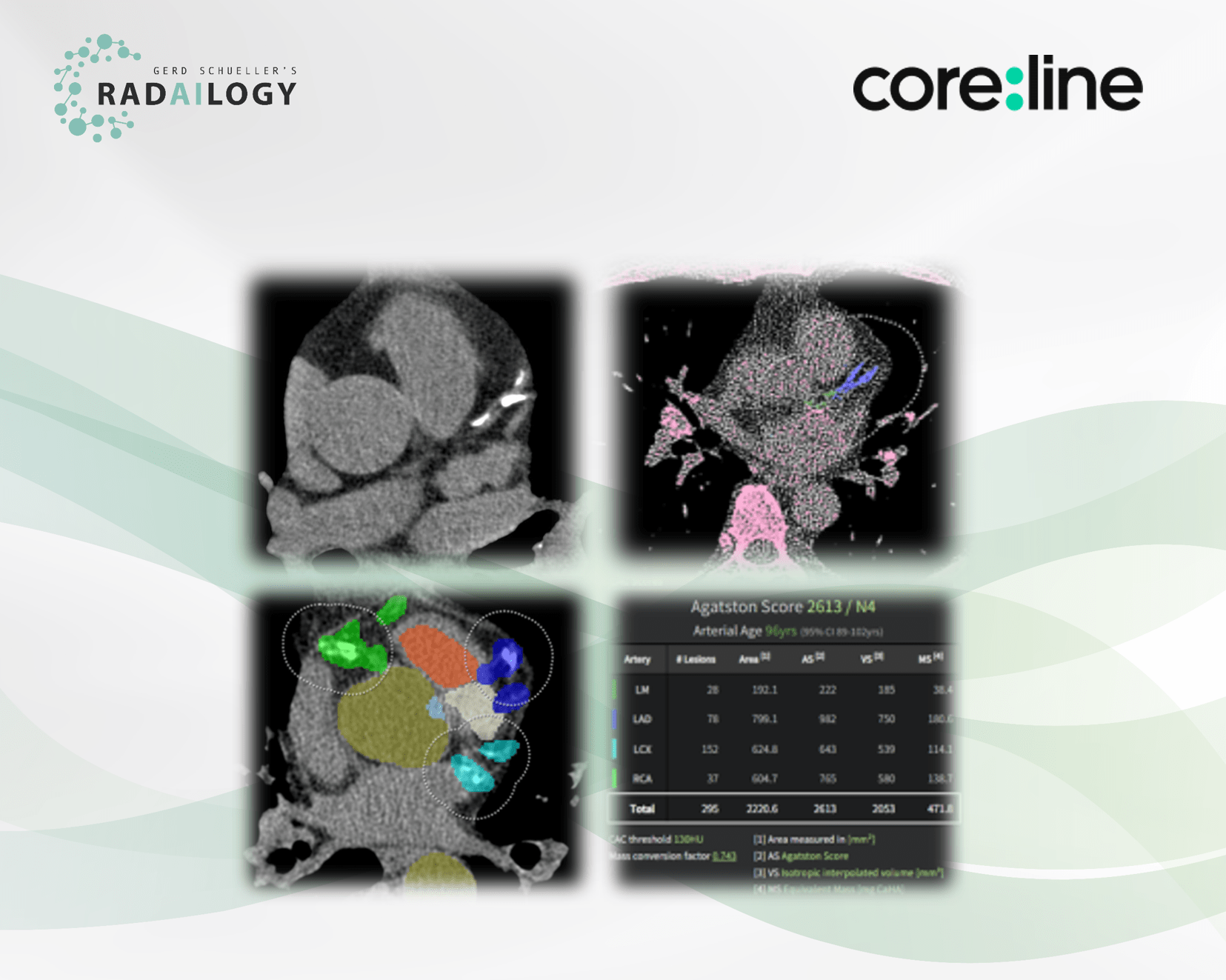Non-enhanced chest CT of a 65-year-old patient; 120 Kvp; axial reformation; soft tissue reconstruction kernel. aview CAC segments all cardiac structures and detects coronary artery calcium in all coronary arteries, calculates an Agatston score of 2613, a visually estimated score of 2053, the total area of calcifications of 2220.6 mm² and the equivalent amount of calcium of 471.8 mg. The score according to the CAC-DRS scoring system is 2613/N4 and represents a high risk of a heart attack.
Calcium deposits narrow the coronary arteries and increase the risk of a heart attack. Calcium scoring in a simple CT scan of the chest provides information about whether your coronary arteries are affected by this arteriosclerosis.
It is with great pleasure that we present aview CAC, an AI assistant for the CT of the heart.
Why aview CAC matters and how it works
Coronary artery calcium (CAC) is a marker of overall coronary atherosclerotic burden. As such, it is an important tool in cardiovascular risk stratification and preventive treatment of asymptomatic patients with unclear cardiovascular disease risk.
aview CAC is a new AI assistant for coronary artery segmentation and labeling. It detects and analyzes calcium in the coronary arteries using CT scans of the chest by measuring the Agatston score.
Patients with a high Agatston score are at increased risk of a heart attack.
Who benefits
Taking your age and gender into account, aview CAC can be used to calculate how high your risk of a heart attack is.
If you have already had a screening CT of your lungs, you can upload this study to Radailogy and you will receive information about this risk quickly and reliably.
If coronary artery calcium is detected, coronary disease is more likely, regardless of whether you feel symptoms or not. It also means that possible follow-up examinations (CT angiography of the coronary arteries or MRI of the heart) allow conclusions to be drawn about the development of the disease and the effectiveness of therapy.
Our own experience at Radailogy
aview CAC calculates the results according to the CAC-DRS Scoring System. The AI assistant uses the modifier “Ax” or “Vx” to represent the Agatston or visually estimated CAC score, respectively, with x corresponding to the CAC score category. Next, the number of affected arteries is outlined with the modifier “Ny,” with y corresponding to the number of affected categories.
Both modifiers are then combined and separated by a virgule to give a composite CAC-DRS score (Ax/Ny or Vx/Ny). The calculation is based on the weighted highest density score (HU) multiplied by the area of the calcification speck. The density score outlines the risk factor: 130-199 HU: 1; 200-299 HU: 2; 300-399 HU: 3; 400+ HU: 4.
The test is performed quickly and accurately with low interreader variation. In addition, aview CAC´s proprietary kernel conversion technology improves accuracy and performance for quick analysis. The results are demonstrated in clear numbers and well understandable pictures.
The scientific evidence
Vonder M, Zheng S, Dorrius MD, van der Aalst CM, de Koning HJ, Yi J, Yu D, Gratama JWC, Kuijpers D, Oudkerk M. Deep Learning for Automatic Calcium Scoring in Population-Based Cardiovascular Screening. JACC Cardiovasc Imaging. 2022 Feb;15(2):366-367.
Aldana-Bitar J, Cho GW, Anderson L, Karlsberg DW, Manubolu VS, Verghese D, Hussein L, Budoff MJ, Karlsberg RP. Artificial intelligence using a deep learning versus expert computed tomography human reading in calcium score and coronary artery calcium data and reporting system classification. Coron Artery Dis. 2023 Sep 1;34(6):448-452.
Suh YJ, Kim C, Lee JG, Oh H, Kang H, Kim YH, Yang DH. Fully automatic coronary calcium scoring in non-ECG-gated low-dose chest CT: comparison with ECG-gated cardiac CT. Eur Radiol. 2023 Feb;33(2):1254-1265.
Data to upload to Radailogy
Non-enhanced chest CT studies of any CT scanner; 120 Kvp; axial reformations; slice thickness and interval 2.5-3 mm each; soft tissue reconstruction kernel

